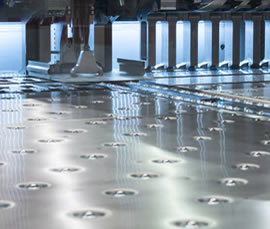
Metal stamping is a common manufacturing process. Also known simply as metal pressing, it involves the use of a stamping press to deform and shape a metal workpiece. Metal workpieces typically consist of sheet metal. To alter the shape of a piece of sheet metal, manufacturing companies can stamp it. How does metal stamping work exactly?
The Basics of Metal Stamping
Although it sounds complex, metal stamping is a relatively simple manufacturing process. It requires the use of a stamping press to deform and shape a metal workpiece. Stamping presses are heavy-duty machines that essentially sandwich a metal workpiece between a set of dies. They typically have one die on top and another die on the bottom.
During use, the stamping press will push the top die down onto the bottom die. Since the metal workpiece is placed between these two dies, it will take their respective shape. The bottom of the metal workpiece will take the shape of the bottom die. The top of the metal workpiece, on the other hand, will take the shape of the top die.
Parts of a Stamping Press
Although there are several types of stamping presses, most of them consist of a few basic parts. They have a bolster plate, for instance. Located on the top of the bed, the bolster plate is the component on which the bottom die is placed.
In addition to a bolster plate, most stamping presses have a ram or slide. The ram or slide is the top part that presses down onto the metal workpiece. Some of them use a mechanical ram or slide, whereas others use a hydraulic ram or slide. Regardless, most stamping presses have this part. It’s one of the main components of a stamping press, and it’s needed to deform and shape metal workpieces.
Benefits of Metal Stamping
Metal stamping has become a popular manufacturing process because of the benefits it offers. It’s considered a cold-working technique that, like other cold-working techniques, doesn’t heat-related changes to the metal workpieces with which it’s used. Metal stamping won’t expose metal workpieces to heat. Therefore, there’s no risk of heat-related changes. Metal workpieces can be deformed and shaped via metal stamping without being exposed to heat.
Metal stamping is also a cost-efficient manufacturing process. By using metal stamping, manufacturing companies can produce products more quickly and efficiently. The efficient nature of metal stamping makes it a popular choice among large manufacturing companies.
